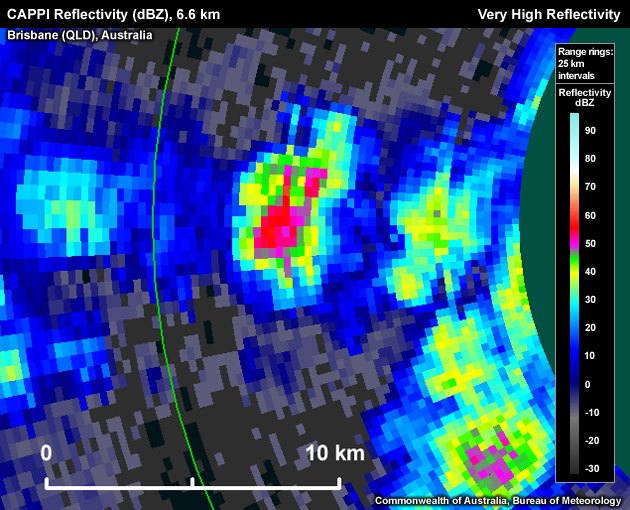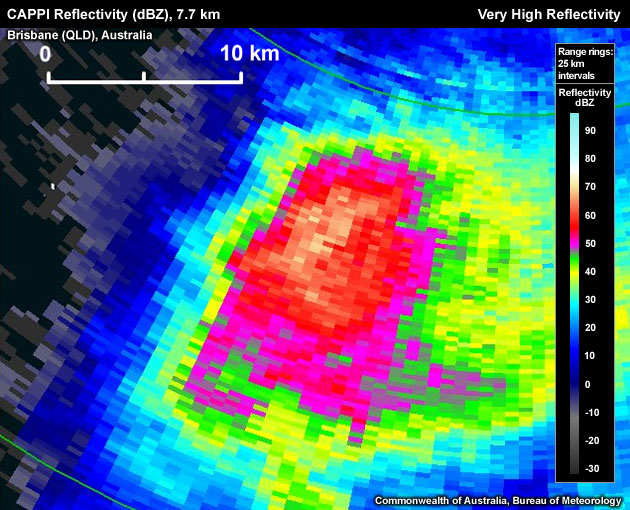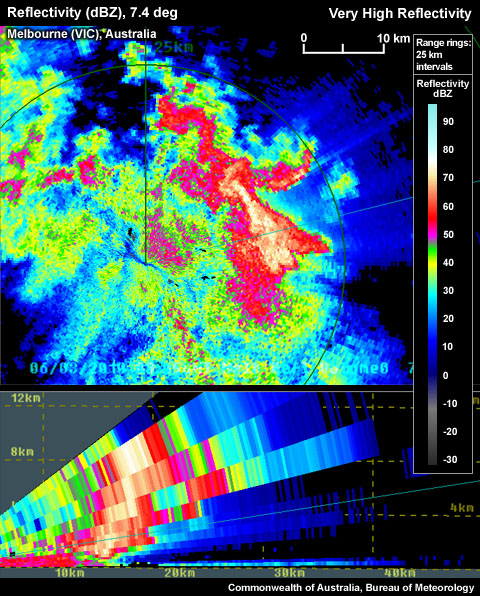Diagnosis
Once you have confidently identified a "very high reflectivity" signature, this section will help you estimate the storm severity associated with it. Generally, the spatial and temporal scales of a signature are loosely related to the updraft strength. In other words, the larger and/or more long–lived the signature, the stronger the updraft that produced it. In velocity-based signatures, updraft severity can usually also be gauged by the magnitude of the measured radial velocities. Examining a storm’s overall temporal evolution will suggest whether the storm is becoming more or less severe. Radar signatures and associated storm developments can also be time-shifted relative to each other, as is the case in supercell tornadoes that occur during the collapse of the parent storm.
When comparing signatures to diagnose relative severity, keep in mind that it is assumed that signatures are sampled at equal ranges from the radar. Otherwise, a storm sampled at greater range (with a wider beam) can appear to be weak and/or weakening, while a storm sampled at a closer range (with a narrower beam) can appear to be strong and/or strengthening.
Degree of Severity
- Horizontal extent of the Very High Reflectivity core – The larger the area of the Very High Reflectivity core, the more likely the storm possesses large amounts of large hail, especially if the signature is detected above the freezing level.

Small horizontal area of approximately 60 dBZ reflectivity echoes

Large horizontal area of >60 dBZ reflectivity echoes

Very large horizontal area of >60 dBZ reflectivity echoes
- Longevity of the Very High Reflectivity core – The more persistent the presence of the Very High Reflectivity core, the more time there is for more large hail to grow, especially if within the hail growth layer. This might also indicate a storm's ability to support a strong and steady core.
- Maximum dBZ of Very High Reflectivity core – The higher the maximum dBZ echoes, the larger the hail size, especially if the maximum dBZ echoes reside in a thermal environment below freezing. Large hail grows primarily in the -10°C to -30°C layer. As it falls through the atmosphere, the hail should remain constant in size, potentially growing slightly until just below the freezing level. At this point the hail is at its maximum size, before gradually melting below the freezing level. Reflectivity values around 55 dBZ found below the freezing level might be large raindrops. On the other hand, reflectivities greater than 70 dBz require consideration of giant hail (>5cm).
Considering all these aspects of a Very High Reflectivity signature will help to determine overall whether you are dealing with a significantly high reflectivity signature. In the context of a severe thunderstorm warning decision, the most significant high reflectivity signature should be counted as good evidence of a severe thunderstorm, but should be used in conjunction with other signatures (see related signatures in Conceptual Models). Radar data should never be used in isolation and should always be considered in conjunctionwith the near storm environment and any reports.
Most Likely Convective Hazards
If a thunderstorm has been determined to be severe and possesses a Very High Reflectivity signature of significance, the following convective hazards should be considered to be included in the severe thunderstorm warning:
- Large hail – Very high reflectivities usually directly suggest large hail, providing the updraft extends past the freezing layer, to -10°C to -30°C layer. Some consideration of the temperature of the environment between the high reflectivity core and the ground should be given to identify the potential for melting.
- Heavy rainfall – Potentially very high reflectivities may be representative of heavy rainfall, depending upon the environmental conditions. Also, heavy rainfall could still be produced even if the very high reflectivities are detecting large hail, as a warm low level environment could melt the hail as it descends.
- Damaging winds – A very high reflectivity signature suggests a strong updraft, with potential to produce a strong downdraft, especially if large hail is also forecast.
See Conceptual Models for more details on why particular severe weather should be included.
